It took a stingy merchant to convince Splurgy co-founders Brian Kim and Michi Kono they had stumbled onto a potential jackpot of a business idea.
The small business owner had been trying to negotiate a discount on Splurgy’s flagship offering, a $9-per-month system to affix coupons to the owner’s online store, Kim and Kono say. But the owner also wanted to get wider exposure for his coupons. How much, Kim and Kono wondered, would the merchant pay to have the same coupons placed on other people’s sites, like related blogs and news publications? “About $2,000 per month,” the business owner replied.
The takeaway: Business owners will spend on the order of 100 times more for outbound online promotions than for the same promotions aimed at their existing customers. Kim and Kono are now in the process of rebuilding their young startup around coupon ads, building a network of blogs and news sites in various online verticals where merchants might want to display coupons.
"No one's yet done the most obvious thing to build an audience."Splurgy’s coupons come with a twist: They can only be redeemed via some sort of social media endorsement or activity. They might require you to follow a business on Twitter, like it on Facebook, share it on Facebook, tweet about it, or upload a picture of its offerings to Pinterest. In return, you get a discount, access to content, or entry into a sweepstakes. And if you qualify as a “social VIP” with lots of followers you might even get a better coupon.
In other words, Spurgy sets up a quid pro quo where the customer promotes the merchant on social media and gets a sort of kickback in return. Splurgy's original, $9-per-month coupon system solicited endorsements only at checkout, but the new approach turbocharges the social backscratching by opening up the process to non-customers.
This helps business owners solve the chicken-and-egg problem of social media promotion, where a business's existing followers can help bring in new customers and followers with retweets, likes, and so on. But if a business doesn’t have any followers to begin with it’s stuck. That's what Splurgy aims to fix. Komo says its advertising coupons, which it calls “sponsored promotions,” took one low-profile app developer from virtually no social media mentions to 110 tweets and Facebook shares, all using the same language.
“There’s a big opportunity left on the table,” Komo says. “People go into social media to reach new audiences, and yet the most obvious thing to do to reach an audience, no one has done it yet.”
Splurgy’s sponsored promotion system is still in the development stage, and has been tested on a limited set of customers. But it has a good pedigree. Kim and Kono developed their couponing system while working closely with videogame publisher IGN. IGN was the year-old company’s initial client, and for roughly half of Splurgy’s short life its main focus. IGN used Splurgy to promote a videogame tournament. Half of the people who went to the event used Splugy’s tool, cashing in their social media activity.
Splurgy took a $550,000 series A round in January and plans to graduate sponsored promotions from beta in the next few months. Kim and Kono want to first expand the network of sites willing to advertise their coupons, which they worry is too narrowly focused on a few verticals.
One thing the pair are not worried about is being accused of using bribes to undermine trust in social media. As far as Splurgy is concerned, that ship has sailed. Facebook’s own platforms allow businesses to target “offers” at people who have liked their page.
“Before you hit the button to follow or like or share, you make a decision, is this brand worth my time?” Komo says. “And when you hit that button you’re committed psychologically.”
In other words, the person most likely to be convinced by your endorsement of a business isn’t one of your friends or family, it’s you. And instead of just giving a tweet for a discount, you’re giving out something much more valuable: Your own loyalty.

